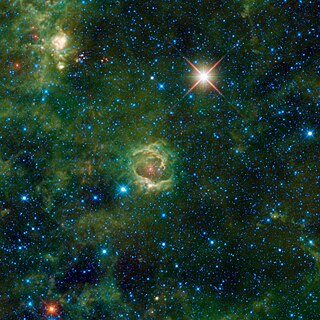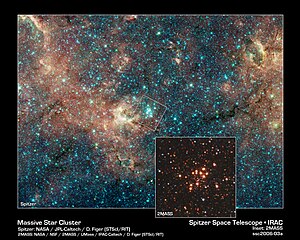
Scutum is a small constellation. Its name is Latin for shield, and it was originally named Scutum Sobiescianum by Johannes Hevelius in 1684. Located just south of the celestial equator, its four brightest stars form a narrow diamond shape. It is one of the 88 IAU designated constellations defined in 1922.

Red supergiants (RSGs) are stars with a supergiant luminosity class of spectral type K or M. They are the largest stars in the universe in terms of volume, although they are not the most massive or luminous. Betelgeuse and Antares A are the brightest and best known red supergiants (RSGs), indeed the only first magnitude red supergiant stars.

The Scutum–Centaurus Arm, also known as Scutum-Crux arm, is a long, diffuse curving streamer of stars, gas and dust that spirals outward from the proximate end of the Milky Way's central bar. The Milky Way has been posited since the 1950s to have four spiral arms — numerous studies contest or nuance this number. In 2008, observations using the Spitzer Space Telescope failed to show the expected density of red clump giants in the direction of the Sagittarius and Norma arms. In January 2014, a 12-year study into the distribution and lifespan of massive stars and a 2013-reporting study of the distribution of masers and open clusters both found corroboratory, though would not state irrefutable, evidence for four principal spiral arms.

A yellow hypergiant (YHG) is a massive star with an extended atmosphere, a spectral class from A to K, and, starting with an initial mass of about 20–60 solar masses, has lost as much as half that mass. They are amongst the most visually luminous stars, with absolute magnitude (MV) around −9, but also one of the rarest, with just 20 known in the Milky Way and six of those in just a single cluster. They are sometimes referred to as cool hypergiants in comparison with O- and B-type stars, and sometimes as warm hypergiants in comparison with red supergiants.

A yellow supergiant (YSG) is a star, generally of spectral type F or G, having a supergiant luminosity class. They are stars that have evolved away from the main sequence, expanding and becoming more luminous.

S Persei is a red supergiant or hypergiant located near the Double Cluster in Perseus, north of the cluster NGC 869. It is a member of the Perseus OB1 association and one of the largest known stars. If placed in the Solar System, its photosphere would engulf the orbit of Jupiter. It is also a semiregular variable, a star whose variations are less regular than those of Mira variables.

A hypergiant (luminosity class 0 or Ia+) is a very rare type of star that has an extremely high luminosity, mass, size and mass loss because of its extreme stellar winds. The term hypergiant is defined as luminosity class 0 (zero) in the MKK system. However, this is rarely seen in literature or in published spectral classifications, except for specific well-defined groups such as the yellow hypergiants, RSG (red supergiants), or blue B(e) supergiants with emission spectra. More commonly, hypergiants are classed as Ia-0 or Ia+, but red supergiants are rarely assigned these spectral classifications. Astronomers are interested in these stars because they relate to understanding stellar evolution, especially star formation, stability, and their expected demise as supernovae.
RSGC3 is a young massive open cluster belonging to the Milky Way galaxy. It was discovered in 2010 in the GLIMPSE survey data. The cluster is located in the constellation Scutum at the distance of about 7 kpc from the Sun. It is likely situated at the intersection of the northern end of the Long Bar of the Milky Way and the inner portion of the Scutum–Centaurus Arm—one of its two major spiral arms.

Stephenson 2, also known as RSGC2, is a young massive open cluster belonging to the Milky Way galaxy. It was discovered in 1990 as a cluster of red supergiants in a photographic, deep infrared survey by the astronomer Charles Bruce Stephenson, after whom the cluster is named. It is located in the constellation Scutum at the distance of about 6 kpc from the Sun. It is likely situated at the intersection of the northern end of the Long Bar of the Milky Way and the inner portion of the Scutum–Centaurus Arm—one of the two major spiral arms.

Melnick 42 is a massive blue supergiant star in the Tarantula Nebula in the Large Magellanic Cloud located in the constellation Dorado. Although it is only 21 times the size of the sun, its high temperature of 47,300 K makes it one of the most luminous stars of the Tarantula Nebula at 3,600,000 L☉. It is less than two parsecs from the centre of the R136 cluster, although that is well outside the central core.

PZ Cassiopeiae is a red supergiant star located in the constellation of Cassiopeia, and a semi-regular variable star.

Westerlund 1 W26 or Westerlund 1 BKS AS is a red supergiant located at the outskirts of the Westerlund 1 super star cluster. It is one of the largest known stars and the most luminous supergiant stars discovered so far with radius calculated to be in excess of a thousand times the solar radius, and a luminosity of over 200,000 times the solar luminosity. If placed at the center of the Solar System, its photosphere would engulf the orbit of Jupiter.

Stephenson 2 DFK 1, also known as Stephenson 2-18, is a red supergiant (RSG) or possible extreme red hypergiant (RHG) star in the constellation of Scutum. It lies near the open cluster Stephenson 2, which is located about 5.8 kiloparsecs away from Earth in the Scutum–Centaurus Arm of the Milky Way galaxy, and is assumed to be one of a group of stars at a similar distance, although some studies consider it to be an unrelated or foreground red supergiant. It is potentially among the largest known stars, one of the most luminous red supergiants, and one of the most luminous stars in the Milky Way.

Westerlund 1-237 or Westerlund 1 BKS B is a possible red supergiant (RSG) in the constellation of Ara. It is one out of four known red supergiants in the Westerlund 1 super star cluster, although its outlying position, spectrum, and parallax, suggest it could be a foreground giant. As a red supergiant, it would be one of the largest known stars and one of the most luminous of its type.

Westerlund 1 W75 or Wd 1-75 is a red supergiant (RSG) located in the Westerlund 1 super star cluster. Its radius is calculated to be around 668 solar radii (4.65 × 108 km, 3.10 au). This corresponds to a volume 298 million times bigger than the Sun. If placed at the center of the Solar System, Westerlund 1-75 would engulf the inner limits of the asteroid belt.
Alicante 10, also known as RSGC6, is a young massive open cluster belonging to the Milky Way galaxy. It was discovered in 2012 in the 2MASS survey data. Currently, eight red supergiants have been identified in this cluster. Alicante 10 is located in the constellation Scutum at the distance of about 6000 pc from the Sun. It is likely situated at the intersection of the northern end of the Long Bar of the Milky Way and the inner portion of the Scutum–Centaurus Arm—one of the two major spiral arms.

V1936 Aquilae is a blue supergiant and candidate Luminous blue variable located in the nebula Westerhout 51, in the constellation Aquila, about 20,000 light years away. The star was originally identified as a massive star in 2000, and was thought to be an O-type supergiant. However, subsequent analyses have shown it to be not O but B-type, as well as being possibly an LBV.

IRAS 18357–0604 is a yellow hypergiant (YHG) star located in the constellation of Scutum, estimated to be about 19,600 light years, or 6,000 parsecs, away. IRAS 18357–0604 is remarkably similar to IRC +10420, another yellow hypergiant in the constellation of Aquila.
Stephenson 2 DFK 49 or St2-11 is a putative post red supergiant star in the constellation Scutum. It is located in the massive open cluster Stephenson 2. It is possibly one of the largest known stars with radius estimates ranging from 884 solar radii to 1,300 solar radii. If the upper estimate is correct, then Stephenson 2 DFK 49 has a volume 2.2 billion times that of the Sun. If it was placed at the center of the Solar System, its photosphere will potentially approach or engulf Jupiter's orbit. It loses mass at a very high rate, resulting in large amounts of Infrared excess.












